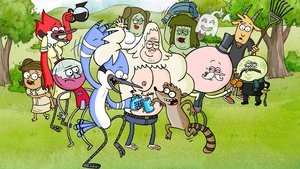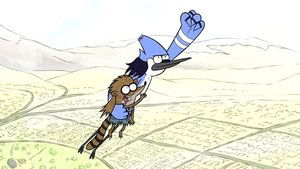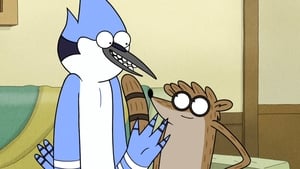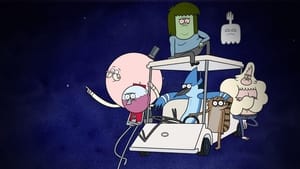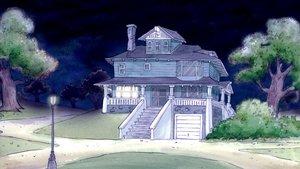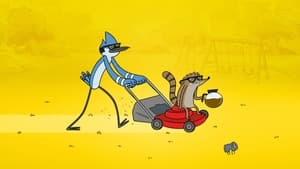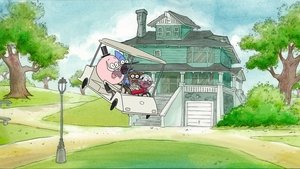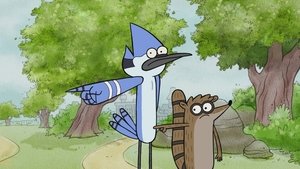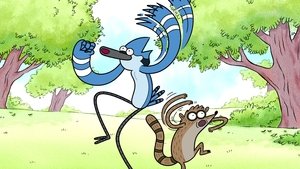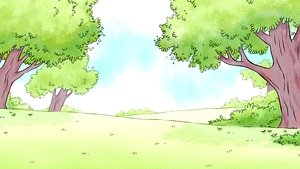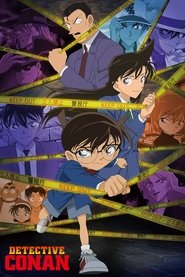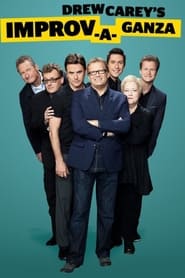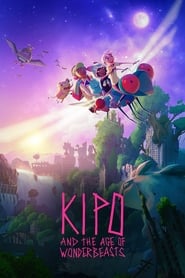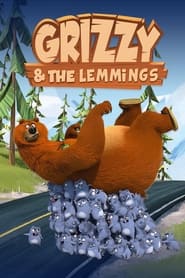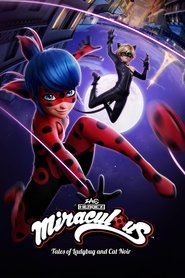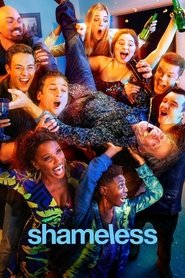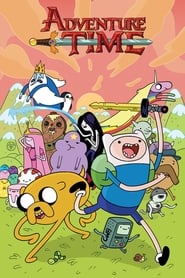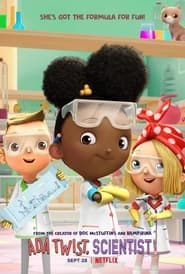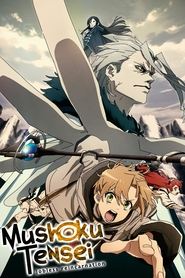
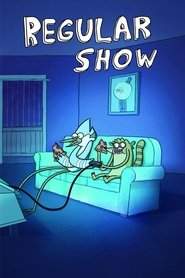
Creator
Creator
Cast
Mordecai / Hi Five Ghost (voice)
Rigby (voice)
Skips (voice)
Benson / Pops / Muscle Man (voice)
Eileen (voice)
Chance Sureshot / Recap Robot (voice)
Toothpick Sally (voice)
Video trailer
Synopsis
Synopsis
Regular Show is an American animated sitcom that was created by J.G. Quintel and produced through Cartoon Network Studios. The show follows two best buddies, Mordecai (a blue jay) and Rigby (a Raccoon), who are groundskeepers at a local park. Instead of focusing on their job, they choose to relax, engage in video games, and escape responsibility, only to get caught up in the most bizarre fantasies, mystical, and supernatural adventures.

The typical episode starts with a routine or easy task (e.g., clearing, altering, or delivering something) and quickly turns into a myriad of high-stakes and bizarre situations, alternate dimensions such as talking hot dogs, time travel, monsters, as well as cosmic threats. Despite the ridiculous increase in tension, the emotional center frequently returns to family, responsibility, and daily life. The show first ran from 2010 to 2017 and ran for eight seasons.
In its last season, it adopted a space setting, rebranding a segment of the show in the form of the Regular Show Space. The year 2024 was when Warner Bros. Discovery announced the revival of Regular Show for two seasons, with Quintel returning.
Quick Show Information
| Field | Detail |
|---|---|
| Title | Regular Show (also called the Regular Show of Space for Season 8) |
| Creator | J.G. Quintel |
| Production Company | Cartoon Network Studios |
| Original Network | Cartoon Network |
| Original Run | September 6 from 2010 to January 16 December 6, 2010, to January 16, 2017. |
| Seasons | 8 |
| Episodes | 244 episodes (plus specials) |
| Episode Runtime | Usually 11 minutes (some special or extended episodes can run up to 33 minutes) |
| Genre(s) | Comedy, Surreal Comedy, Fantasy, Science Fiction, Action-Adventure, Black Comedy |
| Composer(s) | Mark Mothersbaugh (primary), as well as John Enroth, Albert Fox |
| Awards and Recognition | Nominated for multiple Emmys and was awarded at least an Emmy (for “Eggscellent”) |
| Movie Adaptation | Normal Show The Movie (2015) |
Plot Summary
Since the show can be described as episodic in nature, a summary of the show’s “plot” is not so much about a singular narrative arc but more focused on the constant structure, character development, and the most important events. However, there are moments and threads that merit being highlighted.
Episode Structure and the typical flow
The majority of episodes follow a common pattern:
- Everyday Problem/Task
Mordecai, as well as Rigby, is given a basic or difficult task (e.g., mowing or fixing a radio, making paperwork). - Avoidance/Slacking
They are trying to get away from work, play off, have a distraction, or look for ways to cut corners. It is usually driven by a desire to relax or amusement. - Escalation / Surreal Twist
The everyday problem transforms into something awe-inspiring. The park gets overrun, an object becomes magical, they are transported, or a time/space distortion takes place. The increase in severity is swift and often hilarious. - Confrontation and Resolution
They have to face the bizarre challenge (often with the help of friends or unwilling allies) to fix things (or at the very least, contain any damage) and then enough to resume normal operations before their boss is aware.
In the course of time, there are elements of serialization that appear as character relationships grow and arcs are occasionally multi-episode, as well as dramatic stakes (especially in the final season and late seasons).
Key Characters and Their Functions
- Mordecai (J.G. Quintel), usually the calmer of the two, attempts accountability, but is often drawn into Rigby’s strategies.
- Rigby (William Salyers) — a chaotic, unpredictable, impulsive, and often the cause of problems.
- Benson, their boss, is a gumball machine who often threatens to dismiss them.
- Pops — a childish and sweet character (lollipop-headed), usually in support of Mordecai as well as Rigby.
- Skips -an immortal buti/co-worker capable of being shrewd and fixing numerous supernatural problems.
- Muscle Man: The Muscle Man, rough, green, often funny foil or competitor.
- The Hi-Five Ghost with an arm upon his forehead, faithful and a bit eccentric.
Notable Arcs and Finale
- Over the course of its duration, Regular Show introduced narrative arcs with longer lengths, which included relationship development (Mordecai and Margaret) and personal growth, and ultimately cosmic stakes, particularly during Season 8, which featured Regular Show on Space.
- The final seasons are a lot more intense. The final season takes the drama to an epic level and resolves key plot points and ending characters that carry emotional importance.
- The film ( Regular Show: The Movie) can be considered an expansion later on, but it is not required for the arcs of the show’s main characters.
In the end, Regular Show is a mix of “standalone odd episode-of-the-week” style, with periodic serialized stakes, and sometimes emotional rewards, particularly in the latter seasons.
Themes and Analyses
Despite its bizarre, hilarious appearance, Regular Show has deeper themes and subtleties under its comedy. These are the main concepts and analytical lenses:
Friendship, Loyalty & Growth
The connection of Mordecai as well as Rigby serves as the emotional anchor of the series. Their relationship is challenged by conflicts, mishaps, as well as distance and shifting goals. In time, they improve and remain loyal, even when their actions go beyond logic.
Responsibility Versus Laziness
A constant tension arises from the conflict between accountability (doing work, being right) and temptation (sloth, etc.). The show humorously illustrates the way that routine tasks can be avoided; however, the result is often chaos. This dynamic is a reflection of the real-world tensions of duty vs. procrastination.
The mundane life collides with the Surreal.
One of The Regular Show’s most distinctive features is the interplay between the mundane and the fantastical. It relishes injecting an element of the fantastic into ordinary environments (a park or a radio, for instance, or soda machines). The juxtaposition creates comedy and narrative awe; however, it also hints that everyday life could be a source of wonder or danger.
Growing up and Time
Although Mordecai and Rigby start the show at 23 years old, the show develops over time and is a subtle exploration of aging, change, regrets, ambitions, and. Their casual lifestyle is entertaining; however, there is a deeper issue of where they are heading. Many fans have noted that as the show progresses, it grows in its audience.
Nostalgia & Cultural References
Regular Show draws heavily from references to the 1980s and 1990s, like video games, pop culture, and old songs, both to make a comedic impact and also as connecting tissue for viewers older than. It taps into the collective nostalgia and repurposes the clues to trigger emotional resonance.
Consequences & Redemption
Although many episodes “reset” after the chaos, some carry consequences–characters learn, friendships strain, and goofy choices have consequences. The show doesn’t let the issues go unanswered. While it’s funny, it frequently offers forgiveness, reconciliation, and even growth.
Surrealism as a Mirror of Emotional States
A lot of bizarre incidents reflect relationships or emotional stakes. The breakdown in reality during the course of a story could reflect inner anxiety, confusion, or a sense of fear. The surreal can be a symbol for young adult anxiety or existential fears, as well as changing identities.
All in all, Regular Show is a comedy with a touch of surrealism; however, it does not sacrifice any of heart, character, or thematic depth.
Criticism and Controversy
While widely acclaimed, Regular Show has drawn criticisms and controversies in a variety of ways:
Mature Humor & Inappropriate Content
Since The Regular Show airs through Cartoon Network (traditionally kid-oriented), there are some episodes that contain humorous themes or jokes that involve moderate alcohol consumption, crude humor, violence, or innuendo. In certain countries, this resulted in restrictions on the show or altered versions.
Surrealism Overload and Logical Leaps
Some critics and fans argue that the show can go to the point of the absurd, that it loses its internal logic. The “anything can happen” rapid escalation may feel unbalanced. Some episodes could appear more random rather than a sense of narrative cohesion.
Unbalanced Character Focus
Because Mordecai and Rigby dominate a lot of episodes, other actors (Muscle Man, Hi-Five Ghost, and Pops) sometimes feel unappreciated or over-padded. Some fans complain that some cast members don’t have their due amount of depth.
Pace and Episode Variety
Due to the short duration (often eleven minutes), certain episodes might seem undeveloped or repetitive in their structure. The basic pattern (task avoidance – strange twist resolution) may sometimes seem familiar.
Space Season Reception and Finale
There are a few fans who disagree with the season of space (Season 8). While many are pleased with the dramatic plot escalation, others think the show strayed from the earlier style with its grounded comedy. Some find the ending to be emotional and satisfying, even though it also ends the possibility of future the possibility of a sequel.
Accessibility for new viewers
The show relies heavily on in-jokes, references, and a broader range of character relationships. New viewers might be confused or lose the weight of their emotions without having a sense of familiarity. The escalation style of the show could also turn off those who are more grounded in their love of comedy.
However, Many critics and fans believe that its strengths outweigh its weaknesses, and its originality and emotional sensitivity give it enduring appeal.
Cinematography as well as Style (Animation and Visual Approach)
While The Regular Show is animated, numerous aspects of its stylistic and visual design are crucial to its humor, tone, and distinctiveness.
Artistic Style & Animation Technique
The show is based on hand-drawn processes. According to the creators, the show was largely “low-fi”-characters were drawn on paper, inked, and painted digitally, and then based on digital tools of the present like Cintiq. This gives the show a more natural look and reflects an “individual aesthetic” of the artists.
Backgrounds tend to be highly detailed, with trees, parks, buildings, and skies, encapsulating the surreal moments in real-world settings. Character designs are striking with appealing designs and silhouettes that emphasize the exaggeration of cartoons.
Color, Lighting & Mood
The show typically uses bright, fun colors, particularly when it is set in a normal park. When the show is set in surreal settings or high-tension, the color palettes change, ranging from darker hues to high contrast, striking shadows, and unnatural lighting to reflect the mystical stakes. Episodes that take place in an alternate reality or space could utilize neon or cosmic hues.
Framing, Camera Angles & Motion
Although animation, framing usually mimics cinematic techniques, such as dramatic close-ups of emotions, Dutch angle or blurred framing in chaos, sweeping pans over the landscape or a cosmic view, and fast cuts when there is action or transitions. Movement–camera pans, zoom-ins, tracking–lifts energy.
The stark contrast between static sequences (characters talking or relaxing) and motion sequences (fights or portals, transformations) highlights the escalation.
Integration of surreal Elements & Effects
The show seamlessly integrates characters from the real world, effects digital transformations, portals, and explosions, morphing, along with visual distortions. The elements are created using a unique style, often combining 2D characters and dynamic visual effects. The visual surprises are often a sign of the shift in tone mid-section.
Motifs and Symbols
Recurring visual motifs include:
- The objects (video game consoles, records, soda cans) as triggers, gateways, or gateways
- Clocks, timers, and ticking sounds to create the sense of urgency
- Mirrors, portals, and distortion effects indicate an alternate reality.
- Shadows and silhouettes and exaggerated scale shifts
These visual tools connect the chaotic episodes into a style that is easily recognized and maintain a sense of coherence even when plots change.
Editing and Pace
Due to the short running time, editing is nimble. Scenes are swiftly set up to an escalation and finally to an end. The transitions from surreal moments can be rapid, creating a sense of excitement. The sequence’s placement (quiet conflict, quiet) is designed to maintain tension while allowing breathing space. The show will often return to a calm enough to let the emotional beats echo.
Overall, Regular Show‘s choices of visuals support its mix of humour as well as emotional beats and awe. The aesthetic is playful, but logical.
Cultural Impact
Regular Show has left an impressive legacy in the world of animation, fandom, and pop culture. Here are some of the key aspects of its impact.
Critical Acclaim and Ratings
The film was loved by critics and viewers alike. On Rotten Tomatoes, it holds impressive ratings. The mix of surrealism, humor, and a strong emotional undercurrent earned it a loyal audience. It also received industry recognition, including multiple Emmy nominations, as well as at least one Emmy award.
Broad Audience Appeal
Even though it was broadcast on an organization that’s typically associated with programming for children, Regular Show was a hit with audiences of all ages, teens, and adults due to its mature remarks as well as nostalgic elements, along with its deep emotional realism. Many viewers who grew up watching it are now rewatching the show with fresh eyes.
Nostalgia & 1980s / 1990s Culture Revival
The show’s frequent references to old technology, retro gaming, classic songs, and pop culture fueled an overall nostalgia wave in the media. Regular Show is frequently described as a well-crafted homage to the style of that era.
Impact on Later Animation & Trends
The success of the show helped spread the scope of what Cartoon Network (and other networks) were deemed acceptable for mainstream animation, namely, cartoons with surrealism and layered jokes, and a cross-generational appeal. The subsequent animated series have benefited from the tone of the show, mixing normal environments with fantasy-themed elements and escalation.
Fan Communities & Legacy
The regular-show fandom is in full swing with fans’ artwork, threads for rewatches, merchandise, theory-crafting souvenirs, and conventions. The emotional impact of the final episodes remains a source of inspiration for those who love the show. One fan wrote:
“Regular show that made me weep among the most enjoyable shows I’ve ever seen.”
Another fan noticed how watching the show in adulthood uncovered more depth:
“It is absolutely as a kid’s show against adult animated television shows.”
Revival & Continued Relevance
A return was announced that included two new seasons, as well as the return of the creator J.G. Quintel. This decision demonstrates the popularity of the show and also the conviction in its relevance to the present.
Where to watch the Guts? (Legally)
Here are the legal platforms and ways to watch regular shows (availability is dependent on the region):
- In a number of different countries, the regular show is available to stream.
- Cartoon Network / Boomerang apps/On-Demand -Original network platforms or streaming partners may provide episodes.
- Digital Purchase/Rent Platforms such as iTunes, Amazon Video, Google Play may carry seasons or even episodes.
- DVD/Blu-ray Physical collection (complete seasons, Series box sets) are usually available to purchase.
- Broadcast/ Cable Networks — In certain regions, Cartoon Network or its affiliates continue to rerun as well as licence the Regular Show.
Because the availability of content is dependent on region, I’m able to search the country of your choice (e.g., Pakistan) and see if The Regular Show is legally streamable in that country.
Frequently Answered Questions
- Do you know how many of them there are?
It has 244 hours (plus specials) in eight seasons. - Who came up with The Regular Show?
J.G. Quintel is the author of the concept, drawing inspiration from earlier work by students as well as ideas. - Is the regular show appropriate for kids?
It’s classified as TV-PG. While a lot of episodes are harmless amusement, the show does contain moderate violence, crude comedy, and bizarre themes. It is important to exercise parental discretion for children younger than. - What’s a regular show within Space?
The eighth season is expanded into a setting that is space-based and is sometimes referred to as the Regular Show of Space. The show increases the stakes and expands the scope of cosmic events. - Does there exist any Normal Show film?
Yes, Regular Show: The Film was released in 2015.
Conclusion
Regular Show is a stunningly simple name for a show, not “regular.” The show’s brilliance is in the way it blends everyday scenes and a slacker-like, relatable lifestyle with surreal fantasies, absurd escalation, humour, and emotional subtleties. Through its eight seasons, it brought the right amount of heart, humor, and imagination often within less than eleven minutes for each episode.
The core of The Regular Show is a show about friendship, growing up, responsibilities, and the wacky, magical undertones of everyday life. The visual style, narrative boldness, and genuine emotion lift the show above mere comedy to become an iconic animated film.
Original title Regular Show
TMDb Rating 8.628 2,133 votes
First air date Sep. 06, 2010
Last air date Jan. 16, 2017
Seasons 8
Episodes 245
Average Duration 11 minutes








